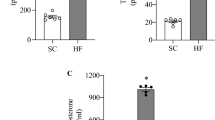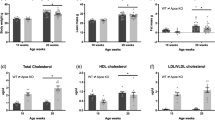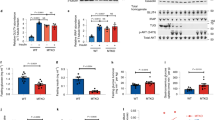Abstract
AIMS/HYPOTHESIS: The aim of the present study was to investigate the relationship between intramyocytic triglycerides levels, muscle TNF-α and GLUT4 expression and insulin resistance.
METHODS: Insulin sensitivity was studied in 14 severely obese women (BMI>40 kg/m2), before and 6 months after low-dietary intake or bariatric malabsorptive surgery (bilio-pancreatic diversion, BPD), by the euglycaemic hyperinsulinaemic clamp technique, while the amount of intramyocytic triglycerides was chemically measured in needle muscle biopsies. Using reverse transcriptase‐polymerase chain reaction analysis, the muscle mRNA expression of TNF-α and GLUT4 was also investigated.
RESULTS: The weight loss after surgery was 25.98±5.81 kg (P<0.001), while that obtained with the diet was 5.07±5.99 kg (P=NS). Marked decrease in TNF-α mRNA levels (76.67±12.59 to 14.01±5.21 AU, P<0.001) were observed in comparison with pre-treatment, whereas GLUT4 was significantly increased (62.25±11.77–124.25±21.01 AU, P<0.001) only in BPD patients. Increased glucose uptake (M) was accompanied by a significant decrease of TNF-α mRNA (76.67±12.59–14.01±5.21 AU, P<0.01) and an increase of GLUT4. The amounts of TNF-α mRNAs in skeletal muscle correlated inversely with GLUT4 mRNAs and directly with intramyocytic triglycerides levels. In a step-down regression analysis (r2=0.95) TNFα mRNA (P=0.0014), muscular TG levels (P=0.018), and GLUT4 mRNA (P=0.028) resulted to be the most powerful independent variables for predicting M values.
CONCLUSION/INTERPRETATION: These findings suggest that insulin resistance in morbidly obese patients is positively associated to the intramyocytic triglycerides content and to TNF-α gene expression and inversely correlated to GLUT4 expression.
This is a preview of subscription content, access via your institution
Access options
Subscribe to this journal
Receive 12 print issues and online access
$259.00 per year
only $21.58 per issue
Buy this article
- Purchase on Springer Link
- Instant access to full article PDF
Prices may be subject to local taxes which are calculated during checkout




Similar content being viewed by others
References
Hotamisligil GS, Spiegelman BM . Tumor necrosis factor alpha: a key component of the obesity-diabetes link Diabetes 1994 43: 1271–1278.
Saghizadeh M, Ong JM, Garvey WT, Henry RR, Kern PA . The expression of TNF alpha by human muscle: relationship to insulin resistance J Clin Invest 1996 97: 1111–1116.
Ofei F, Hurel S, Newkirk J, Sopwith M, Taylor R . Effects of an engineered human anti-TNF-alpha antibody (CDP571) on insulin sensitivity and glycemic control in patients with NIDDM Diabetes 1996 45: 881–885.
De Fronzo RA, Jacot E, Jequier E, Maeder E, Wahren J, Felber JP . The effect of insulin on the disposal of intravenous glucose: results from indirect colorimetry and hepatic and femoral venous catheterization Diabetes 1981 30: 1000–1007.
Pan DA, Lillioja S, Kriketos AD, Milner MR, Baur LA, Bogardus C, Jenkins AB, Storlien LH . Skeletal muscle triglyceride levels are inversely related to insulin action Diabetes 1997 46: 983–988.
Pagliassotti MJ, Pan DA, Prach P, Koppenhafer T, Storlien L, Hill JO . Tissue oxidative capacity, fuel stores and skeletal muscle fatty acid composition in obesity-prone and obesity-resistant rats Obes Res 1995 3: 459–464.
Mingrone G, De Gaetano A, Greco AV, Capristo E, Benedetti G, Tacchino RM, Castagneto M, Gasbarrini G . Reversibility of insulin resistance in obese diabetic patients: role of plasma lipids Diabetologia 1997 40: 599–605.
Manco M, Mingrone G, Greco AV, Capristo E, Gniuli D, De Gaetano A, Gasbarrini G . Insulin resistance directly correlates with increased saturated fatty acids in skeletal muscle triglycerides Metabolism 2000 49: 220–224.
Gasbarrini G, Mingrone G, Greco AV, Castagneto M . An 18-year-old woman with familial chylomicronaemia who would not stick to a diet Lancet 1996 348: 794.
Mingrone G, Henriksen FL, Greco AV, Krogh LN, Capristo E, Gastaldelli A, Castagneto M, Ferrannini E, Gasbarrini G, Beck-Nielsen H . Triglyceride-induced diabetes associated with familiar lipoprotein lipase deficiency Diabetes 1999 48: 1258–1263.
Scopinaro N, Gianetta E, Civalleri D, Bonalumi U, Bachi V . Biliopancreatic bypass for obesity: II. Initial experience in man Br J Surg 1979 66: 619–620.
Moore FD, Olesen KH, McMurrey JD, Parker HV, Ball MR, Boyden CM . The body cell mass and its supporting environment WB Saunders: Philadelphia, PA 1963.
Culebras JM, Moore FD . Total body water and the exchangeable hydrogen I. Theoretical calculation of nonaqueous exchangeable hydrogen in men Am J Physiol 1977 232: R54–R59.
Heymsfield SB, Lichtman S, Baumgartner RN, Wang J, Kamen Y, Aliprantis A, Pierson RN Jr . Body composition of humans: comparison of two improved four-compartment models that differ in expense, technical complexity, and radiation exposure Am J Clin Nutr 1990 52: 52–58.
Bonora E, Del Prato S, Bonadonna RC, Gulli G, Solini A, Shank ML, Ghiatas AA, Lancaster JL, Kilcoyne RF, Alyassin AM, DeFronzo RA . Total body fat content and fat topography are associated differently with in vivo glucose metabolism in non obese and obese non diabetic women Diabetes 1992 41: 1151–1159.
DeFronzo RA, Tobin JD, Anders R . Glucose clamp technique: a model for quantifying insulin secretion and resistance Am J Physiol 1979 237: E214–E223.
Passi S, Rothschild-Boros MC, Fasella P, Nazzaro-Porro M, Whitehouse D . An application of high performance liquid chromatography to analysis of lipids in archaeological samples J Lipid Res 1981 22: 778–784.
Garland PB, Randle PJ . A rapid enzymatic assay for glycerol Nature 1962 196: 987–988.
Bergmeyer HU . (ed.) Methods of enzymatic analysis 2nd ed. Academic Press: New York 1974.
Ferrannini E, Natali A, Bell P, Cavallo-Perin P, Lalic N, Mingrone G . Insulin resistance and hypersecretion in obesity J Clin Invest 1997 100: 1166–1173.
Fabris R, Nisoli E, Lombardi AM, Tonello C, Serra R, Granzotto M, Cusin I, Rohner-Jeanrenaud F, Federspil, Carruba MO, Vettor R . Preferential channeling of energy fuels toward fat rather than muscle during high free fatty acids availability in rats Diabetes 2001 50: 601–608.
Greco AV, Mingrone G, Giancaterini A, Manco M, Morroni M, Cinti S, Granzotto M, Vettor R, Camastra S, Ferrannini E . Insulin resistance in morbid obesity. Reversal with intramyocellular fat depletion Diabetes 2002 51: 144–151.
Randle PJ, Garland PB, Hales CN, Newsholme EA . The glucose-fatty acid cycle. Its role in insulin sensitivity and the metabolic disturbances of diabetes mellitus Lancet 1963 1: 785–789.
Hotamisligil GS, Arner P, Caro JF, Atkinson RL, Spiegelman BM . Increased adipose tissue expression of tumor necrosis factor-α in human obesity and insulin resistance J Clin Invest 1995 95: 2409–2415.
Nisoli E, Carruba MO, Tonello C, Macor C, Federspil G, Vettor R . Induction of fatty acid translocase/CD36, peroxisome proliferator-activated receptor-γ-2 (PPARγ-2), leptin, uncoupling proteins 2 and 3, and Tumor Necrosis Factor-α gene expression in human subcutaneous fat by lipid infusion Diabetes 2000 49: 495–496.
Socher SH, Martinez D, Craig JB, Kuhn JG, Oliff A . Tumor necrosis factor not detectable in patients with clinical cancer cachexia J Natl Cancer Inst 1988 80: 595–598.
Grunfeld C, Feingold KR . Seminars in medicine of the Beth Israel Hospital, Boston: metabolic disturbances and wasting in the acquired immunodeficiency syndrome New Engl J Med 1992 327: 329–337.
Noguchi Y, Yoshikawa T, Marat D, Doi C, Makino T, Fukuzawa K, Tsuburaya A, Satoh S, Ito T, Mitsuse S . Insulin resistance in cancer patients is associated with enhanced tumor necrosis factor α expression in skeletal muscle Biochem Biophys Res Commun 1998 253: 887–892.
Kahn BB . Type 2 diabetes: when insulin secretion fails to compensate for insulin resistance Cell 1998 92: 593–596.
Gura T . Obesity sheds its secrets Science 1997 275: 751–753.
Patti ME, Kahn CR . Lessons from transgenic and knockout animals about non-insulin-dependent diabetes mellitus Trends Endocrinol Metab 1996 7: 311–319.
Liu LS, Spelleken M, Rohrig K, Hauner H, Eckel J . Tumor necrosis factor-alpha acutely inhibits insulin signaling in human adipocytes: implication of the p80 tumor necrosis factor receptor Diabetes 1998 47: 515–522.
Peraldi P, Xu M, Spiegelman BM . Thiazolidionediones block tumor necrosis factor-alpha-induced inhibition of insulin signaling J Clin Invest 1997 100: 1863–1869.
Cheung AT, Ree D, Kolls JK, Fuselier J, Coy DH, Bryer-Ash M . An in vivo model for elucidation of the mechanism of tumor necrosis factor-α (TNF-α)-induced insulin resistance: evidence for differential regulation of insulin signaling by TNF-α Endocrinology 1998 139: 4928–4935.
Uysal KT, Wiesbrock SM, Marino MW, Hotamisligil GS . Protection from obesity-induced insulin resistance in mice lacking TNF-alpha function Nature 1997 389: 610–614.
Kern PA . Obesity: common symptom of diverse gene based metabolic dysregulations. Potential role of TNF and lipoprotein lipase as candidate genes for obesity J Nutr 1997 127: 1917–1922.
Andoh A, Takaya H, Araki Y, Tsujikawa T, Fujiyama Y, Bamba T . Medium- and long-chain fatty acids differentially modulate Interleukin-8 secretion in human fetal intestinal epithelial cells J Nutr 2000 130: 2636–2640.
Author information
Authors and Affiliations
Corresponding author
Rights and permissions
About this article
Cite this article
Mingrone, G., Rosa, G., Di Rocco, P. et al. Skeletal muscle triglycerides lowering is associated with net improvement of insulin sensitivity, TNF-α reduction and GLUT4 expression enhancement. Int J Obes 26, 1165–1172 (2002). https://doi.org/10.1038/sj.ijo.0802053
Received:
Revised:
Accepted:
Published:
Issue Date:
DOI: https://doi.org/10.1038/sj.ijo.0802053
Keywords
This article is cited by
-
Adipogenic progenitors in different organs: Pathophysiological implications
Reviews in Endocrine and Metabolic Disorders (2022)
-
Raspberry alleviates obesity-induced inflammation and insulin resistance in skeletal muscle through activation of AMP-activated protein kinase (AMPK) α1
Nutrition & Diabetes (2018)
-
Co-activator binding protein PIMT mediates TNF-α induced insulin resistance in skeletal muscle via the transcriptional down-regulation of MEF2A and GLUT4
Scientific Reports (2015)



